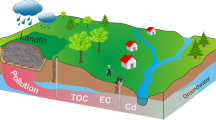Abstract
The study area is located in the plain of Kherraza (NE Algeria), in the Wadi Boudjemaa basin. The latter has a longitudinal lenticular form.
Access provided by CONRICYT-eBooks. Download conference paper PDF
Similar content being viewed by others
Keywords
1 Introduction
The study area is located in the plain of Kherraza (NE Algeria), in the Wadi Boudjemaa basin. The latter has a longitudinal lenticular form. It is limited to the South by the Belilieta and Bouhamra metamorphic mountains and the Edough massif to the North. The eastern edge of the region is drained by the Boudjemaa wadi.
To evaluate groundwater pollution in the Kherraza Plain (agriculture, urban and industrial discharges), water chemical analyses were carried out on nearly 34 points.
2 Materials and Methods
The aquifer system of the kherraza plain consists essentially of two types of aquifer (Hani 2003): a surface aquifer contained in sand formations (with average permeability between 10−3 and 10−4 ms−1) and a deep aquifer consisting of conglomeratic and gravelly formation surmounted by a clay layer whose thickness varies from 15 to 25 m. Most of the wells that capture this aquifer are artesian (Fig. 1).
Location, sketch and geological sections of the study area: 1: Undifferentiated quaternary, 2: Ancient alluvium, 3: clays, 4: Conglomerates and gravels, 5: Metamorphic formations, 6: Fault, 7: Wells, 8: Geological section, 9: piezometric level. («Modified after Messaoudi et al. (2006)»)
For the hydrochemical study, we use chemical analyzes results of 34 samples taken at different points covering the study area. Physical and chemical parameters pH, T °C, CE, Eh, MES, TDS were measured in site using a WTW multiparameter (P3 PH/LF-SET multiline). The analysis of the chemical elements was carried out using two methods: flame atomic absorption (Perkin-Elmer 1100) for the determination of major cations concentrations and the Photolab Spektral spectrophotometer of the WTW brand to evaluate the anions and trace element contents.
To evaluate the health risk assessment (HRA), the lead (Pb) contents observed in groundwater are used. The daily dose of exposure (DDE) is the dose of substance received by the body in relation to the weight of the individual and the number of days of exposure. Expressed in mg/kg/day, it aims to define the amount of pollutants administered.
The EDD for different exposure scenarii is calculated by the same equations that are adapted for each of the exposure pathways (ASTM 1998, US EPA 1989):
where:
- C:
-
= the concentration in the exposure medium (mg/kg)
- Q:
-
= the ingested quantity (kg)
- Fsp:
-
= the absorption factor
- De:
-
= exposure time (years)
- Fe:
-
= the exposure frequency (day/year)
- P:
-
= the weight of the individual (Kg)
- t:
-
= the time period over which the exposure is averaged (days)
The Acceptable Daily Dose (ADD) is the daily amount of chemicals that can be ingested by a person during his lifetime without any noticeable health risk.
The risk assessment depends on the substance that may be carcinogenic or not. The estimation of the non-carcinogenic risk is expressed as the ratio of the daily dose of exposure to the acceptable daily dose. The ratio is called the risk index (RI).
If RI is less than 1, then the toxic risk is considered acceptable.
3 Results and Discussion
The results obtained show a large pollutant load carried by the Boudjemaa Wadi water (chlorides: 900 mg.l−1, BOD5 = 34 mg.l−1, nitrites = 2 mg.l−1). They also show a significant qualitative degradation of groundwater, particularly in downstream areas of the wadi. In these polluted areas, the following values are observed: Electrical conductivity (EC) greater than 3 mScm−1, PO −34 = 20 mg.l−1 and total Fe = 6.4 mg.l−1. These concentrations largely exceed the standard value for drinking water.
In the calculation of total RI, all transfer routes (ingestion, dermal contact, inhalation, vegetables consumption, etc.) were taken into consideration. The results are reported on Table 1 which shows that the risk is unacceptable (greater than 1) for the majority of water points in the study area. This situation threatens nearby, and even distant, populations and wildlife.
4 Conclusion
The present work refers to a case study of groundwater pollution by urban and industrial effluents and storage of solid industrial waste on the ground. Contaminant levels gradually increase from upstream to downstream, creating a potential risk to the Boudjemaa wadi ecosystem and the Mediterranean Sea. The detailed risk assessment to human health shows that it is mainly the ingestion of waters that present the highest risk for the population of the Kherraza plain.
References
ASTM (American Society for Testing and Materials). Standard Provisional Guide for Risk-Based Corrective Action, PS 104–98. ASTM, Philadelphia. (1998).
Hani A. Analyse méthodologique de la structure et des processus anthropiques : application aux ressources en eau d’un bassin côtier méditerranéen. Th. Doct. Es-Sciences, Univ. Annaba. (2003);p.214.
Messaoudi IS, Toumi N. Impact des rejets urbains sur l’environnement dans la plaine ouest de Annaba. Mémoire d’ingenieur: Université Badji Mokhtar Annaba; 2006. p. 60.
US EPA. Risk Assessment Guidance for Superfund, Vol. 1, Human Health Evaluation Manual (EPA/1–89/002). US EPA, Washington, DC. (1989).
Author information
Authors and Affiliations
Corresponding author
Editor information
Editors and Affiliations
Rights and permissions
Copyright information
© 2018 Springer International Publishing AG
About this paper
Cite this paper
Djorfi, S., Djorfi, S., Beloulou, L. (2018). Urban and Industrial Wastes Induced Water Pollution Diagnosis and Risk Assessment of the Kherraza Plain Aquifer (N-E Algeria). In: Kallel, A., Ksibi, M., Ben Dhia, H., Khélifi, N. (eds) Recent Advances in Environmental Science from the Euro-Mediterranean and Surrounding Regions. EMCEI 2017. Advances in Science, Technology & Innovation. Springer, Cham. https://doi.org/10.1007/978-3-319-70548-4_354
Download citation
DOI: https://doi.org/10.1007/978-3-319-70548-4_354
Publisher Name: Springer, Cham
Print ISBN: 978-3-319-70547-7
Online ISBN: 978-3-319-70548-4
eBook Packages: Earth and Environmental ScienceEarth and Environmental Science (R0)





